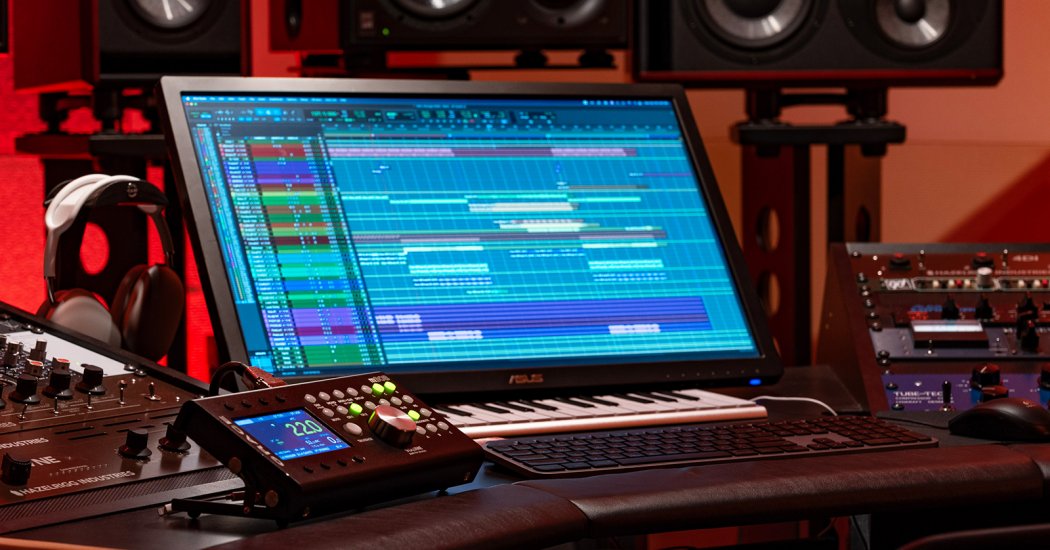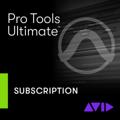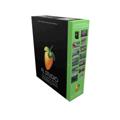
With so many Digital Audio Workstations (DAWs) available today, finding one can feel like a double-edged sword, especially when looking for your first DAW. On the one hand, there’s probably a DAW that suits your goals, your desired workflow, and, most importantly, your budget. On the other hand, finding that ideal DAW can be daunting — a lot of trial and error that wastes a lot of your time and money may occur.
Fortunately, Sweetwater is here to make that process easier so you can make the right purchase from the get-go and feel confident that you’re using the best DAW for you. In this article, we’ll examine our choices for the best recording and mixing DAWs for music and post production. And, of course, we’ll explain why they deserve your consideration.
Note: At Sweetwater, we know there’s no such thing as “best” when it comes to music gear. Every player and artist has unique tastes, which is what makes selecting gear so fun! The items on this list feature some of our favorite products from top manufacturers to help you start your buying journey! Explore these recommendations and dive into Sweetwater’s massive collection of gear on our online store. For personalized picks and expert advice, please contact our knowledgeable Sweetwater Sales Engineers at (800) 222-4700!
- Avid Pro Tools Ultimate
- PreSonus Studio One 6 Professional
- Steinberg Cubase Pro 13
- MOTU Digital Performer 11
- Image Line FL Studio All Plugins Edition
- Reason Studios Reason 12 (Download)
- Bitwig Studio 5.1 DAW Software
- Steinberg Nuendo 13 (Download)
- DAW Buying Guide
Avid Pro Tools Ultimate
Still the professional industry standard
Pro Tools offers multiple versions, and Ultimate is its most feature-laden tier yet. For years, Pro Tools offered something that few other DAWs had: dedicated Digital Signal Processing (DSP) hardware in addition to computer software. This combination gave (and still gives) it the most processing power of any DAW, which is why music and film studios quickly started adopting Pro Tools systems in the mid-to-late ’90s. It’s also why so many still use Pro Tools to this day!
Its dominance in top-tier music studios and post-production houses means that if you dream of recording orchestras or mixing Marvel superhero movies (or at least working remotely with companies that do), then you must know how to operate in Avid Pro Tools Ultimate. Avid’s control surfaces, such as the S6, are also the best in the business. And although they’re usable with any DAW that supports the EUCON protocol, they’re silky smooth when paired with Pro Tools!
PreSonus Studio One 6 Professional
Under one roof from start to finish
Those looking for a streamlined music production workflow should seriously consider PreSonus Studio One 6 Professional. While every DAW on this list can record and mix music, Studio One 6 Professional takes things further with its unique tools that make the mastering and distribution stages that much more excellent!
This DAW handles metadata better than any other DAW on this list, too, allowing you to create a DDP and even import album artwork directly into the DAW itself. Studio One’s ability to update mastering projects instantly from mixing projects is a massive timesaver. Also, its own Native effects plug-ins allow you to route sidechains easily with one click. Together with its Splitter plug-in, this DAW gives you many flexible routing options more quickly and with less effort than other DAWs. Finally, Studio One 6 Professional joins a handful of DAWs that now offer support for Dolby Atmos and various other immersive audio formats.
Steinberg Cubase Pro 13
Turn your computer into an Atmos studio
Long known as a composition powerhouse favored by Hans Zimmer, Steinberg Cubase Pro 13 has some amazing recording and mixing tools, such as its Control Room, MixConsole, and Workspaces.
The Control Room allows you to set up a custom monitoring environment with up to four studio mixes for performers. It also has integrated talkback and managing audio feeds from other sources without an external monitor controller. The MixConsole’s function is found in its name: a full mixing console built directly into the DAW that, when paired with Workspaces, will supercharge your mixing workflow. Additionally, Cubase 13 Pro adds the new Channel Tab feature, which lets you mix individual channels without needing to leave the main arrangement window.
Cubase’s Logical Editor is incredibly deep and can perform complex, multistep operations in seconds. And, as one of the first DAWs on this list to implement a fully integrated Dolby Atmos renderer plus Head Tracking capabilities (the first being Steinberg’s other professional DAW, Nuendo), Cubase Pro 13 is a clear winner if you’d like to create immersive audio content as efficiently as possible.
MOTU Digital Performer 11
A one-stop shop for media composers
As MOTU Digital Performer 11 is one of the older DAWs on this list, its features have been refined over time, making it very stable and less taxing on your computer than most other DAWs. V-Racks are a testament to this; they enable you to load one virtual instrument or effects processor and then use it in multiple “sequences” without needing to load it repeatedly for each sequence.
The Digital Performer’s mixing board lets you mix V-Rack and sequence tracks for a unique and intuitive mixing workflow. Media composers have long flocked to the Digital Performer, and with this version’s new articulation maps and MIDI Polyphonic Expression (MPE) support, we suspect that will continue. This DAW’s notation and arrangement features have set the industry standard for years, and its new always-on recording ensures that no “happy accident” goes uncaptured. Those looking for a solid, all-around DAW with a small computer footprint should strongly consider MOTU Digital Performer 11.
Image Line FL Studio All Plugins Edition
The iconic beat-making DAW — now on Mac
Few DAWs have more dedicated communities than the Image Line FL Studio series, and it’s not hard to see why. The Image Line FL Studio All Plugins Edition is likely the most cost-effective DAW on this list. It’s the only one featured here with neither a paid subscription model nor paid upgrades. Buy it once, and you’re all set! And that one-time purchase gives you serious bang for your buck, with easy-to-use synths, effects, and tools that rival any DAW.
Most DAWs have separate tools for pitch correction and time manipulation. But FL Studio does both in a single, elegant editor known as NewTone, which has everything you need for vocal correction. Plus, this DAW’s Edison editor is more than adequate at removing noise from recordings. Any financially savvy producer looking to maximize their ROI would be hard-pressed to find a better investment than the FL Studio All Plugins Edition from Image Line.
Reason Studios Reason 12 (Download)
A powerful DAW and plug-in that plays nice
Reason Studios’ virtual rack was revolutionary when first introduced, and thanks to the scalable, high-resolution graphics of Reason Studios Reason 12, it now looks better than ever. These advancements, combined with a new and improved Combinator device, a new Mimic Creative Sampler, and the ability to function as a plug-in within other DAWs, put Reason 12 squarely in the crosshairs of any forward-thinking sound designer, beat maker, or EDM producer.
The Combinator is stunning and lets you completely customize the entire device by adding buttons, faders, knobs, and background images. The Mimic is fantastic for dropping in audio and instantaneously getting musical slices and time-stretched clips that will find a home in your project. Finally, the Reason Rack has the ability to function as a plug-in inside other DAWs, making it a brilliant purchase — even if you already have a primary recording/mixing DAW of choice. Consider all the additional firepower that Reason 12 would bring to the table!
Bitwig Studio 5.1 DAW Software
A DAW for the truly adventurous
Bitwig Studio 5.1 DAW software should be on the radar of anyone who wants to live on the cutting edge and create audio content in unconventional ways. It’s the only DAW on this list available for Linux in addition to Mac and PC. It has some exciting modular features that break the mold of typical recording and mixing processes, too!
Nested device chains are like “devices within devices” that let you route signals in many ways directly from the track itself in both serial and parallel configurations. Plus, wet/dry mix knobs allow for just about anything! Bitwig’s overhauled modulation system smashes conventional modulation to pieces by letting users apply any of its control sources to any other device or plug-in. Bitwig’s five different multi-segment envelope generators (MSEGs) will unlock your creative potential by allowing you to essentially draw your own envelopes, patterns, LFOs, waveforms, and much more. Finally, “The Grid,” an ominously titled feature, is a sound designer’s dream, with modular patching for custom instrument and effects creation.
Steinberg Nuendo 13 (Download)
The other DAW for post-production professionals
Another entry from Steinberg on this list is Nuendo 13, which is the only DAW currently available that is close to rivaling Avid Pro Tools Ultimate in post production. Steinberg Nuendo 11 was the first DAW in the world to have a fully integrated Dolby Atmos renderer (which is still here and better than ever), and Nuendo 13 continues its predecessor’s trailblazing lineage by now offering a fully integrated MPEG-H renderer, as well. Plus, Headphones Match and onboard Head Tracking capabilities allow you to create immersive content without an expensive Atmos 7.1.4 speaker setup.
The ADR system is incredible for recording and editing dialogue, and Nuendo 13 adds new Tonal Match, Voice Separator, and ADR Script Reader functions that give it an in-house versatility that other DAWs would require numerous third-party plug-ins to achieve. Furthermore, Nuendo’s easy implementations with Auto-Align, Soundly, Wwise, Perforce, EdiCue, and other third parties can support any post-production or game audio workflow. It also supports many essential post-production formats, such as Dolby’s ADM, Netflix’s TTAL, AAF, MXF, OMF, and more. Finally, Nuendo 13’s ReConform of audio-to-video recuts must be seen to be believed, and its new Audio Export lets you export an audio file directly into an original video file without needing to spend time rerendering the entire video file in order to hear it with your new audio.
DAW Buying Guide
Before shopping for a DAW, having at least a general idea about what you want to accomplish is essential. Otherwise, it will be hard to tell whether a particular DAW’s features suit you. You might ask yourself: Do I want to work professionally with a top-tier Nashville music studio or a Hollywood post-production house? Or would I rather fill a niche in my local community? Am I looking to work professionally, or would I prefer to create as a hobby? Do I want to work with other artists or mainly produce my own music? Am I looking to only make music? How about sound design and effects for films? What about game audio? Do I only need stereo, or will I also need support for immersive audio formats like Dolby Atmos? After answering these questions, the broad field of DAWs will become much narrower in scope.
What Is a DAW?
DAW stands for “Digital Audio Workstation,” and it falls under the umbrella of NLE, which stands for “Non-linear Editor.” NLEs also include video editing software, such as Blackmagic Design DaVinci Resolve. They’re called “non-linear” because they allow you to edit your project however you like. In other words, when we listen to music, we usually don’t listen to the song’s intro and jump immediately to the bridge; we let the song play, and we listen from start to finish in a linear fashion from beginning to end (or left to right on a screen).
However, when the audio engineer edits a song (or the post-production team edits a film), they might not edit strictly from beginning to end. They might edit the intro, realize something in the bridge needs to be fixed for continuity purposes, and then edit that, thus completely bypassing the first verse and chorus. This ability to edit any part of your project in any order at any time gives this software the “Non-linear Editor” name, and DAWs are the music and audio world’s versions of NLEs.
Common DAW Features Explained
Different DAWs specialize in different things, and audio engineers and producers love to talk shop (and smack) about what their DAWs can do that other DAWs can’t. However, DAWs are primarily the same; fundamentally, they’re all software applications that turn your computer into a powerful audio recording and mixing studio that allows you to:
- Record audio into your computer from external sources (such as a microphone) or use MIDI to record virtual instruments using either an on-screen or external MIDI instrument
- Play audio back either through your internal computer speakers or by routing the audio elsewhere for playback on external speakers
- Edit the captured audio in many ways, such as resizing, changing volume levels, copying and pasting into different sections, and more
- Add effects (such as reverb or delay) to the audio or change other aspects, such as EQ, panning, and more
- Save the edited audio for continued work later
- Export the audio for sharing or distribution in various formats (e.g., WAV, MP3, etc.)
And while it’s not strictly required, many professional DAWs have video engines, so you can also edit sound effects and dialogue or compose music to film.
Choosing the Best DAW for You
Again, while DAWs are fundamentally the same and extremely capable, they each have particular niches that can be significantly different depending on your goals and desired workflow (and, frankly speaking, your budget).
For the professional post-production fledgling, Avid Pro Tools Ultimate and Steinberg Nuendo 13 are excellent for engineers in 2024. For music producers, the options open a little more. If you want to work in immersive audio formats, then Steinberg Cubase Pro 13 and PreSonus Studio One 6 Professional are the clear winners. But if stereo or even 5.1 and 7.1 surround sound are all you need, then we have other contenders.
Beat makers and producers of electronic genres have stood behind Image Line FL Studio and Reason Studios’ Reason for years. And they’re both still solid choices (even as plug-ins). The experimental sound designer or electronic music performer should strongly consider Bitwig Studio 5.1. Finally, MOTU Digital Performer 11 has a solid feature list, low CPU requirements, and an extremely customizable interface that makes it worthy of serious consideration, even if you’re not a media composer.
Sweetwater Has the Best DAW for You
The world of DAWs is vast — and getting proficient with the DAW of your choice can take weeks, if not months, of daily use. So, selecting the right DAW is one of the biggest decisions a modern audio engineer and music producer can make. Do they want to be working professionals, or do they want just to have fun creating music in their home studios? Our Sweetwater Sales Engineers are the industry’s best. With in-depth knowledge of every major DAW currently available, they have you covered. Call (800) 222-4700 to speak with one of them and find your perfect DAW today!











